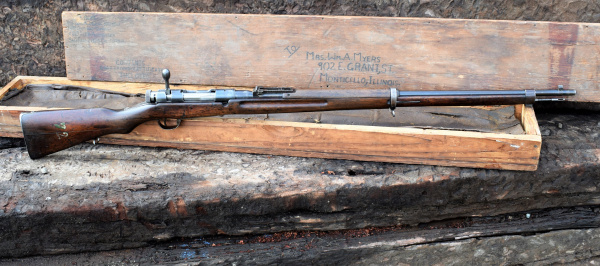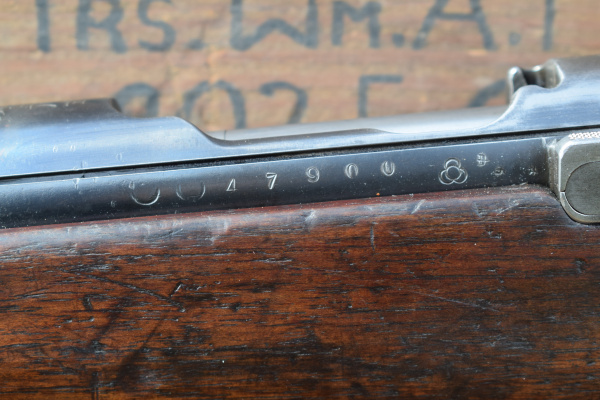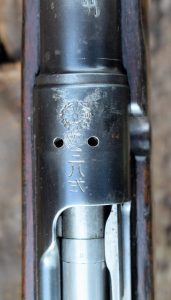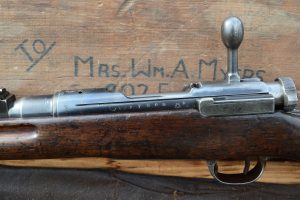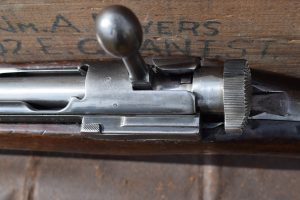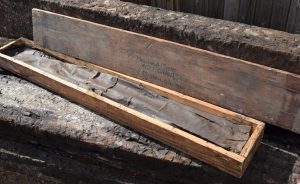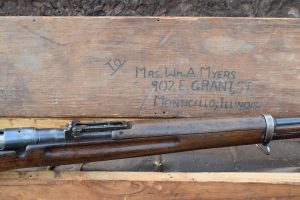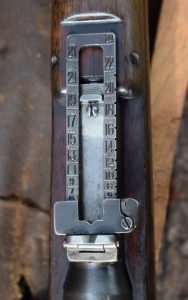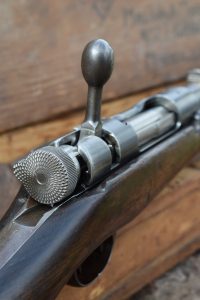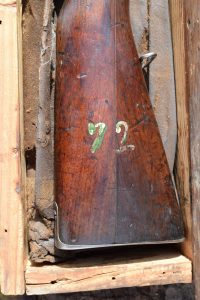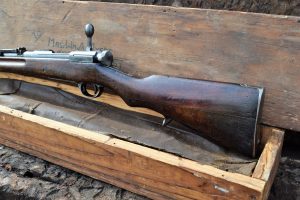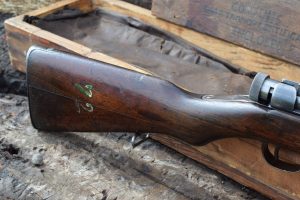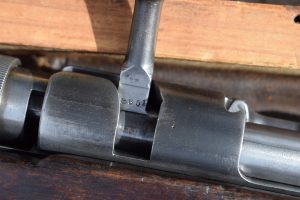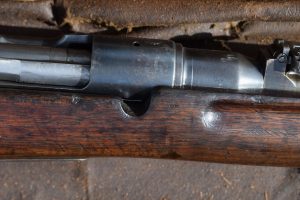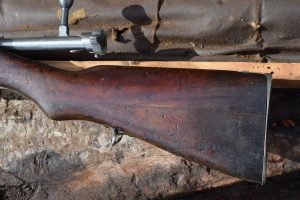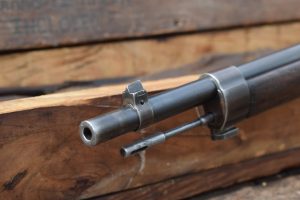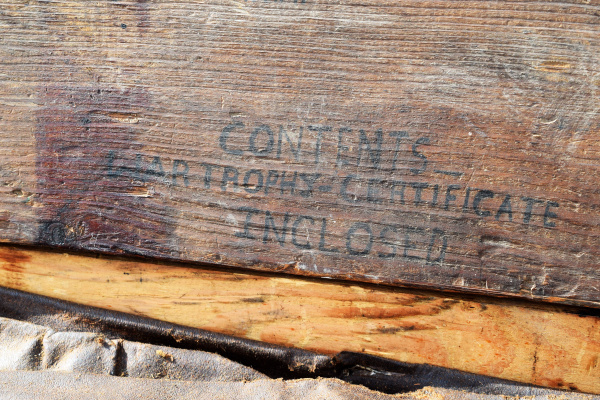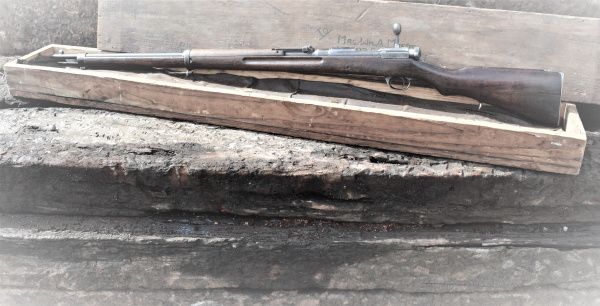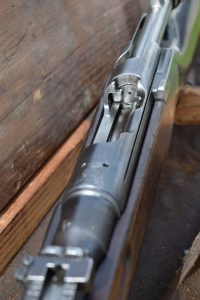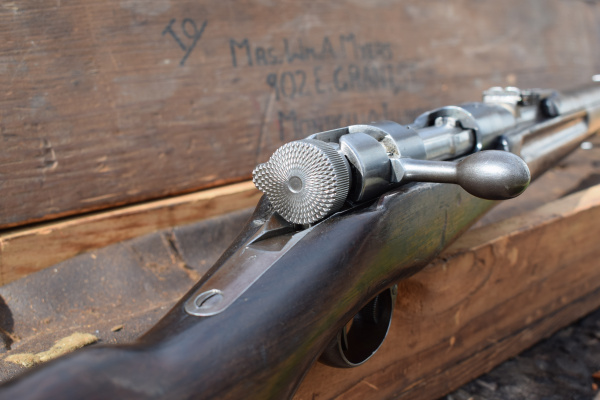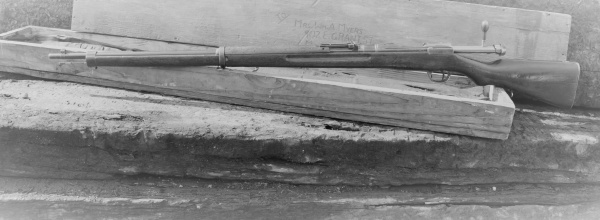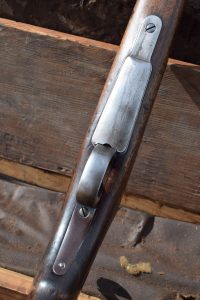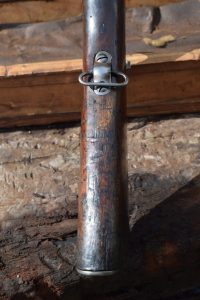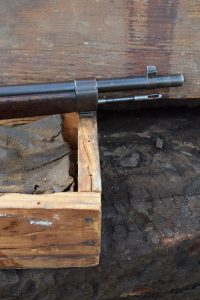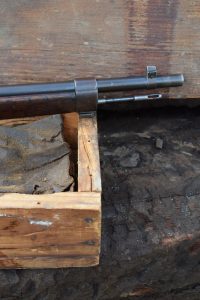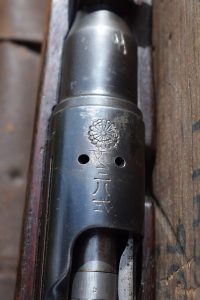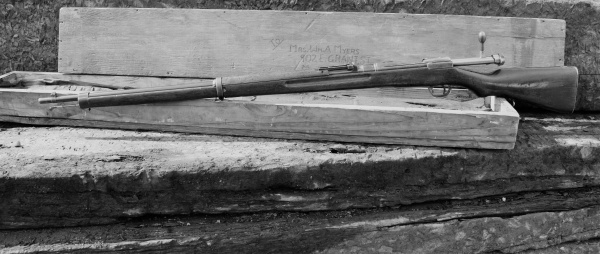Arisaka Type 38 Rifle in G.I. Theatre made Trophy Box…. (F 983)
Created on April 2nd 2022
Superb War Trophy Type 38 Arisaka Rifle complete with Theatre made box
A very rare opportunity to obtain a G.I. trophy in the actual theatre made wooden box it was sent home in. Unfortunately the official paperwork is missing even though mentioned on the exterior. As this example was found in the USA it fits that the address on the lid of the box is an American address. It seems U.S. soldiers had no difficulty in sending home trophies (unlike the British troops who went to all sort of devious measures to conceal their booty) Sending the rifle through the postal system was openly practiced, with no attempt to conceal what was contained within. The type 38 full length Infantry rifle that lies within was produced between 1905 and 1932 and was one of the main rifles of the Imperial Japanese military for that period. They saw action in all conflicts arising within that period and then later on into World War Two. There was also a carbine version in the same calibre. This example looks to be an early example – by serial number.
The rifle is chambered in 6.5mm Japanese with a 5-shot internal magazine and is all “Mauser” in design of the bolt, except for the safety arrangement at the rear of the bolt. This is the main difference between Mauser and Arisaka; a Mushroom headed cocking piece and safety catch arrangement. The rear of the same has a fine geometric pattern machined into the surface of the head. This can be depressed by the open palm and turned from the 9 o’clock position to the 10 o’clock position to apply the safety. There is a pointer on the outside which indicates the positioning. The Japanese military had decided the conventional flag type safeties would be difficult to apply in wet conditions and it would be easier with the open palm. It is actually very easy once you have got used to it. The action has the normal arrangement for withdrawal of the bolt on the rear LHS.
The bright finished bolt has a straight arm and ovoid bolt knob. The bolt is non-matching as is standard practice for rifles surrendered where the two original parts were separated. However, in this case there may be another reason, follow the logic later. The crest of the blued receiver was originally marked with the Emperors Imperial Chrysanthemum and Type markings. The Chrysanthemum has been altered, marked as taken out of service and an additional character added. This is the character for “school”. So, we can deduce that this rifle was taken out of service and remarked for use in a school or college for training purposes. When it was sent back to the US is unknown at the moment as it could have even been after the war when Japan had occupying US troops stationed in re-taken territory. There is a circled triangle mark on both the rear action bridge and the barrel shank which are simple Japanese proof marks.
We do however, know exactly where it was sent and even the family name, this is all detailed upon the lid of the wooden crate. This is all clearly discernible but, for matters of privacy, only visitors will be able to inspect. The address in Illinois, still exists today and it is an image of peaceful idyllic America. Were they his parents or was it his wife he sent his trophy back to ?
The crate itself has survived well and is made from locally scrounged timber and nails. It measures 52″ x 7″ x 4″ externally. Made from 3/4″ thick pine and has weathered well, probably having spent most of its life in an attic or shed. The rifle fits well into the box with the bolt removed. Within the box is an oily thick paper which was wrapped around the rifle for protection. Unfortunately, the certificate mentioned on the lid is missing. One set of details hand written on the lid are as follows: “CONTENTS / WAR TROPHY CERTIFICATE / ENCLOSED.” The other text is slightly more difficult to read but looks to be the details of the sender. It is only possible to make out or deduce the following; ” FROM / _ __ _ _ A. MYERS. 36938883. / 848th ORDNANCE COMPANY / APO 71356 POSTMASTER / SAN FRANCISCO, CALIFORNIA.” Early research finds the 848th on Saipan and Iwo Jima as a Gas Supply Company. Not all soldiers who went away to war were front line assault troops, the whole effort was massive and required all kinds of support, even as mundane as Laundry. However Gas Supply was important and there is no reason why such a position would not face its own share of life threatening dangers, apart from the inherent danger of the fuels they were handling, The initial assault on the islands had to be supported, then the long grinding fight to dislodge the Japanese defenders.
The time line of the rifle seems to be from markings observed:
- Fairly early production at the Tokyo Artillery Arsenal (adopted later after being relocated by Kokura) Having the very similar three stacked canon ball arsenal mark and NO series mark.
- At some point, possibly when production on the Type 99 had begun, the rifle was taken out of service and sent to education department for training. At this point some pretty decent rifles were demoted to second line uses as all hopes were pinned on the new rifle. The two large circle markings adjacent to the serial number were added along with the Chrysanthemum alteration.
- The rifle is recalled to front line service when things aren’t going so well for the Japanese and everything is needed for the war effort. ( Interesting “D /arrow” mark may have been for re-entry inspection)
- From the crate we deduce it was sent to the US from Saipan or Iwo Jima by our U.S. G.I.
It is unusual to be able to track military rifles to specific soldiers or units as the numbers produced on all sides was enormous, in the 100,000’s of any type. So it is particularly interesting and rare to discover this particular interesting information. It is also further reinforced by the fact that this G.I. who sent the rifle home was not some front-line super-soldier, but an ordinary, rather run of the mill participant in such an enormous conflict. Reassuringly it would be the more colourful story that might be fabricated to provide provenance designed to sell an item for an inflated price. It is relevant that it’s mundanity makes it more believable.
The rifle itself benefits from being of fairly early production in that better materials were able to be used. The timber stock is a high quality hardwood which has aged well and has a pleasing patina. The butt is constructed in the conventional timber saving two-piece manner. The RHS of the butt has a rack number “72” painted in 1″ high numerals. The fore-end has 7.1/2″ finger groves to aid grip. Drainage grove on RHS level with receiver. The action has the longitudinal groves or rails for the sliding dust cover – a/f. The round blued barrel has a hand guard in front of the rear sight. The rifle is 50″ long in total. The barrel is 31″ long and the trigger pull is 13″ long to centre. The rifles bluing is strong over the action and barrel and only experiencing wear at the muzzle and rea portion of the action. The straight armed bolt is finished in the white. On the underside of the bolt arm stub is a Japanese character for “7” and then “631.” Showing the bolt has been replaced (when – unknown) The flip-up rear sights are graduated from400 to 2400 meters. Front sight unguarded inverted “V” on a block – adjustable for windage with a dove-tail fixing when zeroing. Full length steel cleaning rod in position under barrel. Twin sling swivels. Stock makers mark between semi-pistol grip and rear sling swivel. Bayonet fixing in front steel forend cap. Steel trigger guard and magazine floor-plate have lost their bluing and are now silver grey, as is the steel butt-plate.
Overall the general patina of the rifle is fine. It has recently passed proof. The bore is dark but rifling complete. However the story this rifle is projecting is highly interesting and quite unique to the collector – a one-off in my experience. Not easy to pop out and find another one locally !
Stock No’ F 983
£ 2640.
Comments Off on Arisaka Type 38 Rifle in G.I. Theatre made Trophy Box…. (F 983)
